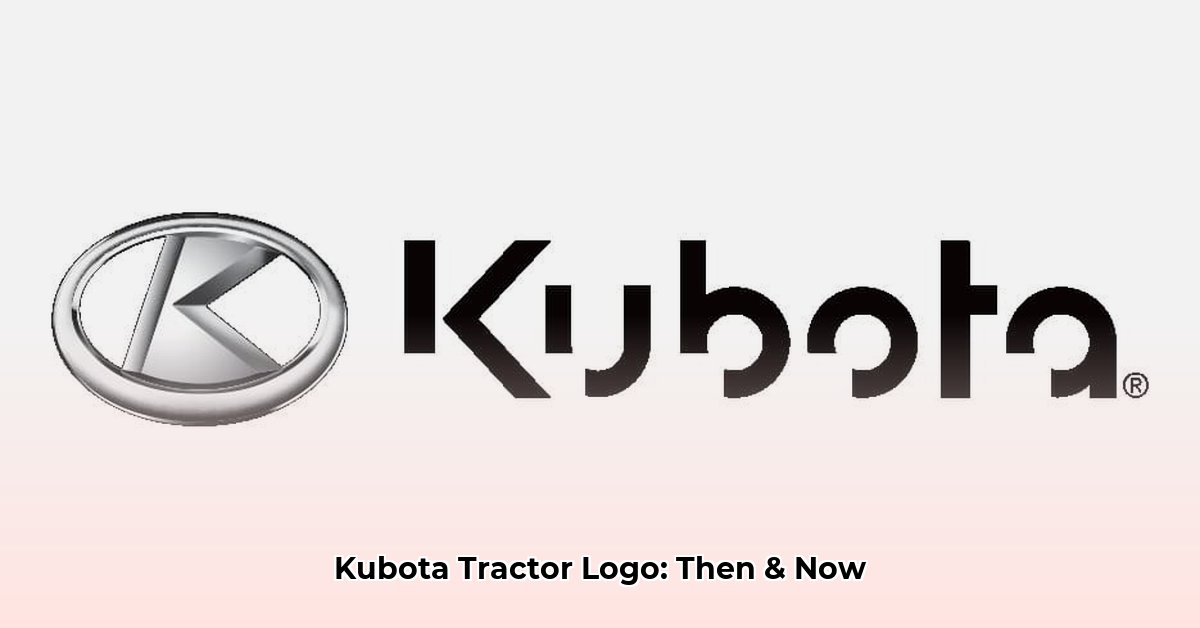
Kubota Tractor Logo: A Visual Story of Growth
The Kubota tractor logo isn't merely a graphic; it's a visual chronicle of the company's remarkable journey from a small Japanese foundry to a global agricultural powerhouse. This evolution reflects not only technological advancements but also a shifting brand identity and a growing commitment to sustainability. The logo's transformation mirrors Kubota's own impressive growth, demonstrating how a well-crafted visual identity can effectively communicate a company's values and aspirations over time. How did a simple logo become such a powerful symbol of innovation and global reach? Need to identify your Kubota's year? Check out this helpful resource: Kubota Tractor Year.
Early iterations of the Kubota logo focused on functionality, mirroring the company's initial focus on precision metalworking. Imagine gears, wrenches—the tools of the trade—clearly communicating expertise in mechanical precision. This practical approach directly spoke to its early customer base, those who understood the language of machinery. This early branding strategy emphasized expertise in metalwork and mechanical precision. But as Kubota's ambitions broadened, so too did its visual identity.
From Workshop to Worldwide: A Changing Identity
Kubota's expansion into agricultural machinery demanded a logo that reflected its evolving role. The focus shifted from showcasing individual products to highlighting the brand itself—a strategic move that signified a transition from a regional player to a significant international competitor. The Kubota name, once a secondary element, took center stage. This subtle shift mirrors the company's transition from showcasing what it made to communicating who made it—a powerful change in messaging.
This pivotal transition likely involved extensive internal discussions about branding and market positioning, with various logo designs explored and tested before settling on the most effective representation of their new image. This period reflects a confident declaration of their presence on the global stage. The early functional designs gave way to a more sophisticated and recognizable brand identity.
The Modern Kubota: Simple, Green, and Sophisticated
Today's Kubota logo is remarkably simple yet powerful. The stylized "K," often accompanied by a calming shade of green, speaks volumes about the company's commitment to sustainability and environmental responsibility. This isn't a mere aesthetic choice; the green subtly communicates Kubota's dedication to eco-conscious practices—a crucial message in today's environmentally aware world. The clean lines and minimalist design project an image of technological advancement paired with social responsibility. This demonstrates a commitment to innovation while maintaining core values.
The minimalist design is likely a deliberate strategy to ensure global recognition, its simplicity transcending cultural and linguistic barriers. Experts in global branding would likely suggest this design promotes broad appeal and instant recognition across varied target markets.
A Visual Timeline: Kubota's Logo Journey
The evolution of the Kubota logo can be summarized in this timeline:
| Period | Logo Characteristics | Company Milestones |
|---|---|---|
| Early Years | Primarily industrial imagery (gears, tools) | Focus on metal castings, primarily local operations. |
| Mid-20th Century | Introduction of Kubota lettering, simplified imagery | Expansion into agricultural machinery and early international sales. |
| Late 20th Century | Brand name becomes dominant, streamlined design | Significant global expansion and technological advancements. |
| Present Day | Stylized "K," incorporation of green, minimalist design | Strong global presence, emphasis on sustainability and technological leadership. |
More Than Just a Logo: A Reflection of Success
The changes to the Kubota logo are more than just aesthetic; they're a direct reflection of the company's growth, its technological advancements, and its evolving values. Each iteration tells a chapter in Kubota's story, from humble beginnings to a position of global leadership in agricultural innovation. The current design effectively embodies both technological leadership and environmental consciousness, showcasing a commitment to a sustainable future. It's a visual testament to their journey and overall success. Isn't it remarkable how a simple logo can communicate such a complex and compelling narrative?
How Kubota's Logo Evolution Reflects Sustainability Initiatives
Key Takeaways:
- Kubota's logo evolution mirrors its growth trajectory, from a small foundry to global leadership.
- The changes reflect technological advancements and evolving corporate strategies.
- The current logo's minimalist aesthetic and color palette strongly communicate sustainability.
- The company’s commitment to sustainability is effectively communicated through its logo’s evolution.
From Foundry to Global Brand: A Visual Timeline
Kubota's journey is evident in its logos. The early designs—simple, industrial images—reflect its origins as an ironworks. The shift to a more formal corporate logo in the 1930s signals diversification beyond its casting roots. The mid-20th century saw sleek, modern logos mirroring Japan's economic boom. The 2010s brought a radical change: the minimalist, striking "K"—a powerful statement of global reach and advanced technology. But the subtle incorporation of green hues is particularly noteworthy.
The Green Shift: Sustainability in Design
The shift to a clean, modern aesthetic with green hues powerfully reflects Kubota's commitment to environmental sustainability. The green isn't accidental; it’s a visual representation of their "For Earth, For Life" campaign and commitment to environmental responsibility. The simplicity reflects corporate maturity and a prioritization of clear communication. This sophistication matches the high-tech nature of their products. It wasn't just an aesthetic change; it was a strategic communication of evolving values.
A Legacy of Adaptation
Kubota's logo evolution is a case study in successful branding. The company adapted its visual identity to reflect both internal growth and external consumer preferences. It demonstrates how a brand can constantly evolve while upholding its core values. It's a powerful illustration of how visual identity can be leveraged to communicate a compelling story of growth, innovation, and sustainable values.